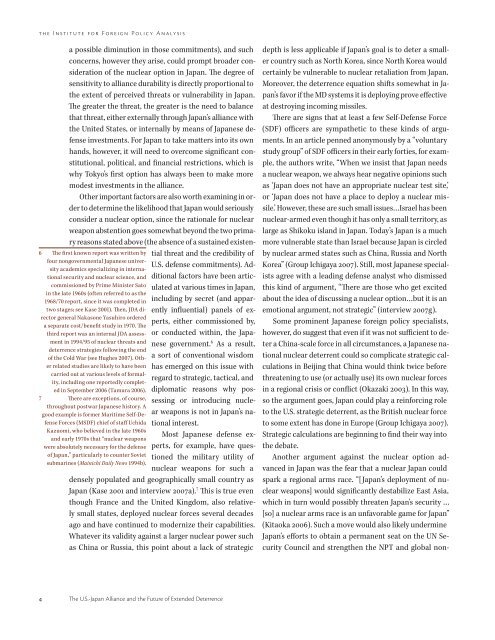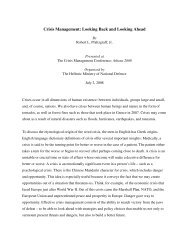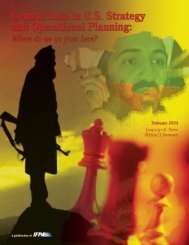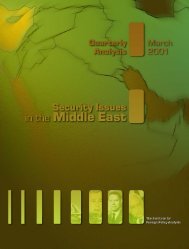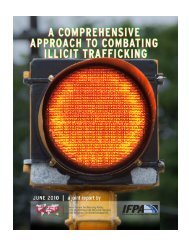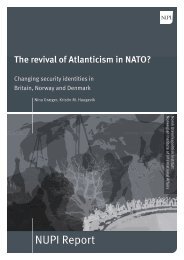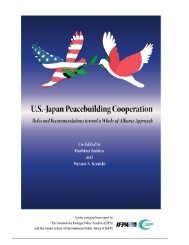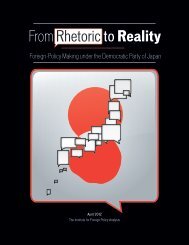Realigning Priorities: The U.S.-Japan Alliance and the Future of ...
Realigning Priorities: The U.S.-Japan Alliance and the Future of ...
Realigning Priorities: The U.S.-Japan Alliance and the Future of ...
You also want an ePaper? Increase the reach of your titles
YUMPU automatically turns print PDFs into web optimized ePapers that Google loves.
t h e I n s t i t u t e f o r F o r e i g n P o l i c y A n a ly s i s<br />
a possible diminution in those commitments), <strong>and</strong> such<br />
concerns, however <strong>the</strong>y arise, could prompt broader consideration<br />
<strong>of</strong> <strong>the</strong> nuclear option in <strong>Japan</strong>. <strong>The</strong> degree <strong>of</strong><br />
sensitivity to alliance durability is directly proportional to<br />
<strong>the</strong> extent <strong>of</strong> perceived threats or vulnerability in <strong>Japan</strong>.<br />
<strong>The</strong> greater <strong>the</strong> threat, <strong>the</strong> greater is <strong>the</strong> need to balance<br />
that threat, ei<strong>the</strong>r externally through <strong>Japan</strong>’s alliance with<br />
<strong>the</strong> United States, or internally by means <strong>of</strong> <strong>Japan</strong>ese defense<br />
investments. For <strong>Japan</strong> to take matters into its own<br />
h<strong>and</strong>s, however, it will need to overcome significant constitutional,<br />
political, <strong>and</strong> financial restrictions, which is<br />
why Tokyo’s first option has always been to make more<br />
modest investments in <strong>the</strong> alliance.<br />
O<strong>the</strong>r important factors are also worth examining in order<br />
to determine <strong>the</strong> likelihood that <strong>Japan</strong> would seriously<br />
consider a nuclear option, since <strong>the</strong> rationale for nuclear<br />
weapon abstention goes somewhat beyond <strong>the</strong> two primary<br />
reasons stated above (<strong>the</strong> absence <strong>of</strong> a sustained existential<br />
threat <strong>and</strong> <strong>the</strong> credibility <strong>of</strong><br />
U.S. defense commitments). Additional<br />
factors have been articulated<br />
at various times in <strong>Japan</strong>,<br />
including by secret (<strong>and</strong> apparently<br />
influential) panels <strong>of</strong> experts,<br />
ei<strong>the</strong>r commissioned by,<br />
or conducted within, <strong>the</strong> <strong>Japan</strong>ese<br />
government. 6 As a result,<br />
a sort <strong>of</strong> conventional wisdom<br />
has emerged on this issue with<br />
regard to strategic, tactical, <strong>and</strong><br />
diplomatic reasons why possessing<br />
or introducing nuclear<br />
weapons is not in <strong>Japan</strong>’s national<br />
interest.<br />
Most <strong>Japan</strong>ese defense experts,<br />
for example, have questioned<br />
<strong>the</strong> military utility <strong>of</strong><br />
nuclear weapons for such a<br />
densely populated <strong>and</strong> geographically small country as<br />
<strong>Japan</strong> (Kase 2001 <strong>and</strong> interview 2007a). 7 This is true even<br />
though France <strong>and</strong> <strong>the</strong> United Kingdom, also relatively<br />
small states, deployed nuclear forces several decades<br />
ago <strong>and</strong> have continued to modernize <strong>the</strong>ir capabilities.<br />
Whatever its validity against a larger nuclear power such<br />
as China or Russia, this point about a lack <strong>of</strong> strategic<br />
6 <strong>The</strong> first known report was written by<br />
four nongovernmental <strong>Japan</strong>ese university<br />
academics specializing in international<br />
security <strong>and</strong> nuclear science, <strong>and</strong><br />
commissioned by Prime Minister Sato<br />
in <strong>the</strong> late 1960s (<strong>of</strong>ten referred to as <strong>the</strong><br />
1968/70 report, since it was completed in<br />
two stages; see Kase 2001). <strong>The</strong>n, JDA director<br />
general Nakasone Yasuhiro ordered<br />
a separate cost/benefit study in 1970. <strong>The</strong><br />
third report was an internal JDA assessment<br />
in 1994/95 <strong>of</strong> nuclear threats <strong>and</strong><br />
deterrence strategies following <strong>the</strong> end<br />
<strong>of</strong> <strong>the</strong> Cold War (see Hughes 2007). O<strong>the</strong>r<br />
related studies are likely to have been<br />
carried out at various levels <strong>of</strong> formality,<br />
including one reportedly completed<br />
in September 2006 (Tamura 2006).<br />
7 <strong>The</strong>re are exceptions, <strong>of</strong> course,<br />
throughout postwar <strong>Japan</strong>ese history. A<br />
good example is former Maritime Self-Defense<br />
Forces (MSDF) chief <strong>of</strong> staff Uchida<br />
Kazuomi, who believed in <strong>the</strong> late 1960s<br />
<strong>and</strong> early 1970s that “nuclear weapons<br />
were absolutely necessary for <strong>the</strong> defense<br />
<strong>of</strong> <strong>Japan</strong>,” particularly to counter Soviet<br />
submarines (Mainichi Daily News 1994b).<br />
depth is less applicable if <strong>Japan</strong>’s goal is to deter a smaller<br />
country such as North Korea, since North Korea would<br />
certainly be vulnerable to nuclear retaliation from <strong>Japan</strong>.<br />
Moreover, <strong>the</strong> deterrence equation shifts somewhat in <strong>Japan</strong>’s<br />
favor if <strong>the</strong> MD systems it is deploying prove effective<br />
at destroying incoming missiles.<br />
<strong>The</strong>re are signs that at least a few Self-Defense Force<br />
(SDF) <strong>of</strong>ficers are sympa<strong>the</strong>tic to <strong>the</strong>se kinds <strong>of</strong> arguments.<br />
In an article penned anonymously by a “voluntary<br />
study group” <strong>of</strong> SDF <strong>of</strong>ficers in <strong>the</strong>ir early forties, for example,<br />
<strong>the</strong> authors write, “When we insist that <strong>Japan</strong> needs<br />
a nuclear weapon, we always hear negative opinions such<br />
as ‘<strong>Japan</strong> does not have an appropriate nuclear test site,’<br />
or ‘<strong>Japan</strong> does not have a place to deploy a nuclear missile.’<br />
However, <strong>the</strong>se are such small issues…Israel has been<br />
nuclear-armed even though it has only a small territory, as<br />
large as Shikoku isl<strong>and</strong> in <strong>Japan</strong>. Today’s <strong>Japan</strong> is a much<br />
more vulnerable state than Israel because <strong>Japan</strong> is circled<br />
by nuclear armed states such as China, Russia <strong>and</strong> North<br />
Korea” (Group Ichigaya 2007). Still, most <strong>Japan</strong>ese specialists<br />
agree with a leading defense analyst who dismissed<br />
this kind <strong>of</strong> argument, “<strong>The</strong>re are those who get excited<br />
about <strong>the</strong> idea <strong>of</strong> discussing a nuclear option…but it is an<br />
emotional argument, not strategic” (interview 2007g).<br />
Some prominent <strong>Japan</strong>ese foreign policy specialists,<br />
however, do suggest that even if it was not sufficient to deter<br />
a China-scale force in all circumstances, a <strong>Japan</strong>ese national<br />
nuclear deterrent could so complicate strategic calculations<br />
in Beijing that China would think twice before<br />
threatening to use (or actually use) its own nuclear forces<br />
in a regional crisis or conflict (Okazaki 2003). In this way,<br />
so <strong>the</strong> argument goes, <strong>Japan</strong> could play a reinforcing role<br />
to <strong>the</strong> U.S. strategic deterrent, as <strong>the</strong> British nuclear force<br />
to some extent has done in Europe (Group Ichigaya 2007).<br />
Strategic calculations are beginning to find <strong>the</strong>ir way into<br />
<strong>the</strong> debate.<br />
Ano<strong>the</strong>r argument against <strong>the</strong> nuclear option advanced<br />
in <strong>Japan</strong> was <strong>the</strong> fear that a nuclear <strong>Japan</strong> could<br />
spark a regional arms race. “[<strong>Japan</strong>’s deployment <strong>of</strong> nuclear<br />
weapons] would significantly destabilize East Asia,<br />
which in turn would possibly threaten <strong>Japan</strong>’s security …<br />
[so] a nuclear arms race is an unfavorable game for <strong>Japan</strong>”<br />
(Kitaoka 2006). Such a move would also likely undermine<br />
<strong>Japan</strong>’s efforts to obtain a permanent seat on <strong>the</strong> UN Security<br />
Council <strong>and</strong> streng<strong>the</strong>n <strong>the</strong> NPT <strong>and</strong> global non-<br />
4<br />
<strong>The</strong> U.S.-<strong>Japan</strong> <strong>Alliance</strong> <strong>and</strong> <strong>the</strong> <strong>Future</strong> <strong>of</strong> Extended Deterrence


